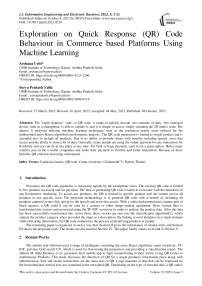Exploration on Quick Response (QR) Code Behaviour in Commerce based Platforms Using Machine Learning
Автор: Archana Uriti, Surya Prakash Yalla
Журнал: International Journal of Information Engineering and Electronic Business @ijieeb
Статья в выпуске: 5 vol.15, 2023 года.
Бесплатный доступ
The "rapid response" code, or QR code, is made to quickly decode vast amounts of data. Any managed device, such as a smartphone, is able to capture it, and it is simple to access simply scanning the 2D matrix code. The dataset is analyzed utilizing machine learning techniques, such as the confusion matrix score utilized for the multinomial naive Bayes algorithm's performance analysis. The QR code generation is limited to single product and is extended now to include all products. Due to its ability to provide clients with benefits including speedy, error-free access and the ability to store a lot of data. Generally, many people are using the online payment for any transaction for flexibility and one can do at any place at any time. For bulk or huge payment, cash is not a good option. Hence many retailers join in the e-wallet companies and make their payment so flexible and faster transaction. Because of these benefits, QR code has becoming widespread.
Confusion matrix, qr code, count vectorizer, gridsearchcv, python tkinter
Короткий адрес: https://sciup.org/15018883
IDR: 15018883 | DOI: 10.5815/ijieeb.2023.05.01
Список литературы Exploration on Quick Response (QR) Code Behaviour in Commerce based Platforms Using Machine Learning
- Bala Krishna, M., & Dugar, A. (2016). Product authentication using QR codes: a mobile application to combat counterfeiting. Wireless Personal Communications, 90(1), 381-398. DOI:10.1007/s11277-016-3374-x
- Tkachenko, I., Puech, W., Destruel, C., Strauss, O., Gaudin, J. M., & Guichard, C. (2016). Two-level QR code for private message sharing and document authentication. IEEE Transactions on Information Forensics and Security, 11(3), 571-583. https://doi.org/10.1109/TIFS.2015.2506546
- Singh, S. (2016). QR code analysis. International Journal of Advanced Research in Computer Science and Software Engineering, 6(5).
- Xu, S. (2018). Bayesian Naïve Bayes classifiers to text classification. Journal of Information Science, 44(1), 48-59. https://doi.org/10.1177/0165551516677946
- Verma, C., Stoffová, V., & Illés, Z. (2018). An ensemble approach to identifying the student gender towards information and communication technology awareness in European schools using machine learning. Int. J. Eng. Technol, 7(4), 3392-3396. doi: 10.14419/ijet.v7i4.14045
- Bordoloi, D. J., & Tiwari, R. (2014). Optimum multi-fault classification of gears with the integration of evolutionary and SVM algorithms. Mechanism and Machine Theory, 73, 49-60. https://doi.org/10.1016/j.mechmachtheory.2013.10.006
- Beniz, D., & Espindola, A. (2016). Using Tkinter of python to create a graphical user interface (GUI) for scripts in LNLS. WEPOPRPO25, 9, 25-28.
- Parmar, P. S., Biju, P. K., Shankar, M., & Kadiresan, N. (2018, September). Multiclass text classification and analytics for improving customer support response through different classifiers. In 2018 International Conference on Advances in Computing, Communications, and Informatics (ICACCI) (pp. 538-542). IEEE. http://dx.doi.org/10.1109/ICACCI.2018.8554881
- Fang, X., & Zhan, J. (2015). Sentiment analysis using product review data. Journal of Big Data, 2(1), 1-14. DOI 10.1186/s40537-015-0015-2
- Yadav, P., & Barwal, P. N. (2014). Designing responsive websites using HTML and CSS. International journal of scientific & technology research, 3(11), 152-155.
- Baid, P., Gupta, A., & Chaplot, N. (2017). Sentiment analysis of movie reviews using machine learning techniques. International Journal of Computer Applications, 179(7), 45-49. doi:10.5120/ijca2017916005
- Chatterjee, N., Chakraborty, S., Decosta, A., & Nath, A. (2018). Real-time communication application based on android using Google firebase. Int. J. Adv. Res. Comput. Sci. Manag. Stud, 6(4).
- Chintada, K. R., Yalla, S. P., & Uriti, A. (2021, November). A Deep Belief Network Based Land Cover Classification. In 2021 Innovations in Power and Advanced Computing Technologies (i-PACT) (pp. 1-5). IEEE. https://doi.org/10.1109/i-PACT52855.2021.9696524
- Uriti, A., Yalla, S. P., & Chintada, K. R. (2021, November). An Approach of Understanding Customer Behavior with an Emphasis on Rides. In 2021 Innovations in Power and Advanced Computing Technologies (i-PACT) (pp. 1-5). IEEE. https://doi.org/10.1109/i-PACT52855.2021.9696837
- Yalla, S.P., Uriti, A., Sethy, A. (2022). GUI implementation of modified and secure image steganography using least significant bit substitution. International Journal of Safety and Security Engineering, Vol. 12, No. 5, pp. 639-643. https://doi.org/10.18280/ijsse.120513


